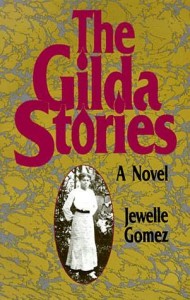The GLBTRT has been reviewing books and movies in its newsletter since the early 1990s. Trace the evolution of queer publishing through these historic reviews. This review was originally published in Vol. 3, No 3, Fall 1991.
 Gomez, Jewelle. The Gilda Stories: A Novel. Firebrand, 1991. Library Binding – Adult. $20.95. (ISBN 0-932379-95-8) Paper. $9.95. (ISBN 0-932379-94-X)
Gomez, Jewelle. The Gilda Stories: A Novel. Firebrand, 1991. Library Binding – Adult. $20.95. (ISBN 0-932379-95-8) Paper. $9.95. (ISBN 0-932379-94-X)
This is an African-American lesbian vampire story. One of the advantages to the vampire format is that the author has several characters who live for hundreds of years – tremendous scope for historical, current and futuristic comment. There is also currently interest in the lesbian vampire as a genre.
There are eight chapters, some of which have appeared as stories in other publications. Perhaps that is why some read as major works in themselves (Yerba Buena, 1890, for example) while others seem less developed (Hampton Falls, New Hampshire, 2020).
The tale begins in 1850 with Girl, a runaway slave, saved by Gilda. Gilda and her lover, Bird, take Girl in and she begins to share their life. Gilda moves on to the true death, and Girl adopts Gilda’s name. From then on, she grows and changes in many ways as she seeks family and belonging. The 200-year span of the story allows time for glimpses of African-American life during slavery; in California at the tum of the last century; the African American section of a small Mid-West town in the 1920’s; Boston in the mid-50’s; New York in the 70’s and 80’s; New Hampshire in 2020; and finally New Mexico and South America in 2050. The time span also permits the author to comment on the coming eco-disaster.
If you enjoy the vampire genre, you may like this book a great deal. A twist on the standard vampire lore is that Gilda is required to give something to those from whom she feeds- because she can read their minds, she tries to give them something they both want and can use. An example of this is a young man who wanted to visit a sick friend, but had procrastinated and was now feeling guilty – she strengthened his resolve to see his friend the very next day.
Gilda’s African-Americanness is not a critical element of the stories after the first chapter, although it remains a central element of the book. Her lesbianism is also simply a part of her, rather than forming the focus of any of the crises.
The book is suitable for collections of contemporary lesbian fiction, gay and lesbian science fiction (but loosely), and fiction about African-Americans.
Reviewed by Susan Lee Sills
University of Calif